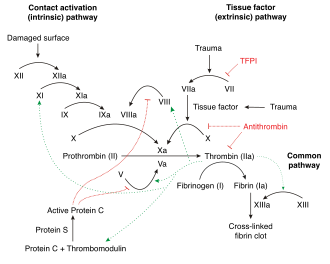Factor XII
Factor XII[edit]

Factor XII, also known as Hageman factor, is a serine protease enzyme of the coagulation cascade in the blood coagulation process. It is a crucial component of the intrinsic pathway of blood coagulation.
Structure and Function[edit]
Factor XII is synthesized in the liver and circulates in the blood plasma as an inactive zymogen. Upon contact with negatively charged surfaces, such as exposed collagen or kallikrein, Factor XII is activated to Factor XIIa. This activation is a key step in the initiation of the intrinsic pathway of coagulation.
Factor XIIa then activates Factor XI, which in turn activates Factor IX, leading to the activation of Factor X and the conversion of prothrombin to thrombin. Thrombin then converts fibrinogen to fibrin, forming a stable blood clot.
Clinical Significance[edit]
Deficiency in Factor XII is a rare condition and is usually asymptomatic, as it does not lead to bleeding disorders. However, it can prolong the activated partial thromboplastin time (aPTT) in laboratory tests. Factor XII deficiency is often discovered incidentally during routine coagulation screening.
Factor XII has also been implicated in the process of inflammation and angiogenesis, and its role in thrombosis is an area of active research.
History[edit]
Factor XII was first discovered in 1955 by Dr. Oscar Ratnoff and Dr. Jane Colopy, who identified it in a patient named John Hageman, after whom the factor is named. Despite its role in the coagulation cascade, individuals with Factor XII deficiency do not typically experience bleeding problems, which led to further investigations into its function.
Related Pages[edit]
Ad. Transform your life with W8MD's Budget GLP-1 injections from $75


W8MD offers a medical weight loss program to lose weight in Philadelphia. Our physician-supervised medical weight loss provides:
- Weight loss injections in NYC (generic and brand names):
- Zepbound / Mounjaro, Wegovy / Ozempic, Saxenda
- Most insurances accepted or discounted self-pay rates. We will obtain insurance prior authorizations if needed.
- Generic GLP1 weight loss injections from $75 for the starting dose.
- Also offer prescription weight loss medications including Phentermine, Qsymia, Diethylpropion, Contrave etc.
NYC weight loss doctor appointmentsNYC weight loss doctor appointments
Start your NYC weight loss journey today at our NYC medical weight loss and Philadelphia medical weight loss clinics.
- Call 718-946-5500 to lose weight in NYC or for medical weight loss in Philadelphia 215-676-2334.
- Tags:NYC medical weight loss, Philadelphia lose weight Zepbound NYC, Budget GLP1 weight loss injections, Wegovy Philadelphia, Wegovy NYC, Philadelphia medical weight loss, Brookly weight loss and Wegovy NYC
|
WikiMD's Wellness Encyclopedia |
| Let Food Be Thy Medicine Medicine Thy Food - Hippocrates |
Medical Disclaimer: WikiMD is not a substitute for professional medical advice. The information on WikiMD is provided as an information resource only, may be incorrect, outdated or misleading, and is not to be used or relied on for any diagnostic or treatment purposes. Please consult your health care provider before making any healthcare decisions or for guidance about a specific medical condition. WikiMD expressly disclaims responsibility, and shall have no liability, for any damages, loss, injury, or liability whatsoever suffered as a result of your reliance on the information contained in this site. By visiting this site you agree to the foregoing terms and conditions, which may from time to time be changed or supplemented by WikiMD. If you do not agree to the foregoing terms and conditions, you should not enter or use this site. See full disclaimer.
Credits:Most images are courtesy of Wikimedia commons, and templates, categories Wikipedia, licensed under CC BY SA or similar.
Translate this page: - East Asian
中文,
日本,
한국어,
South Asian
हिन्दी,
தமிழ்,
తెలుగు,
Urdu,
ಕನ್ನಡ,
Southeast Asian
Indonesian,
Vietnamese,
Thai,
မြန်မာဘာသာ,
বাংলা
European
español,
Deutsch,
français,
Greek,
português do Brasil,
polski,
română,
русский,
Nederlands,
norsk,
svenska,
suomi,
Italian
Middle Eastern & African
عربى,
Turkish,
Persian,
Hebrew,
Afrikaans,
isiZulu,
Kiswahili,
Other
Bulgarian,
Hungarian,
Czech,
Swedish,
മലയാളം,
मराठी,
ਪੰਜਾਬੀ,
ગુજરાતી,
Portuguese,
Ukrainian